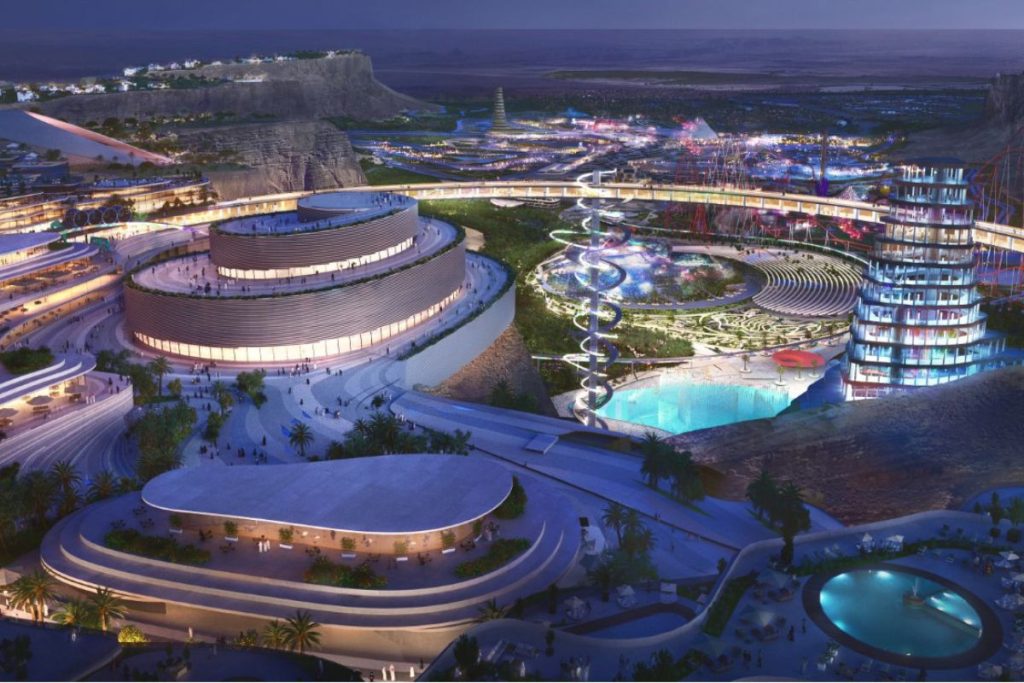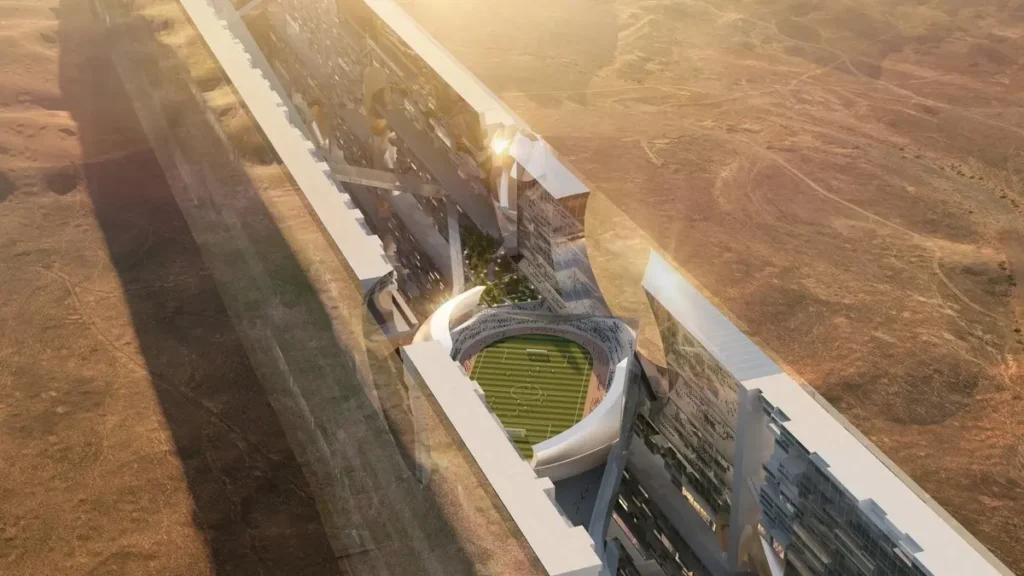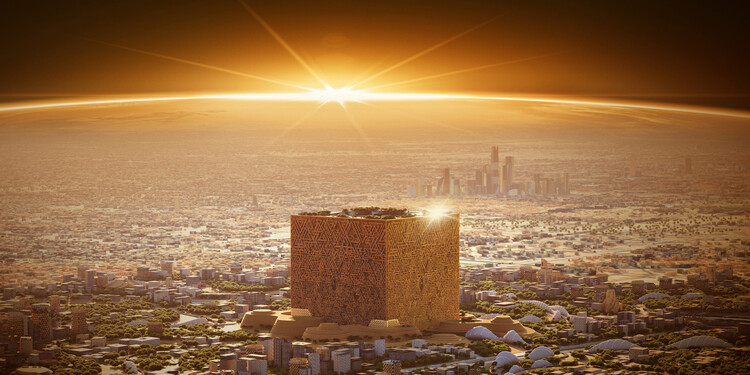Saudi Mega Projects are no longer just blueprints on paper—they are becoming reality and reshaping the economic and cultural landscape of the Kingdom. From futuristic cities like NEOM to massive entertainment hubs like Qiddiya, these projects are part of Vision 2030, Crown Prince Mohammed bin Salman’s ambitious roadmap to diversify Saudi Arabia’s economy away from oil.
Billions of dollars are being invested, creating opportunities in construction, tourism, technology, and green energy. The scale is so vast that the projects are not only transforming Saudi Arabia but also attracting global attention, talent, and investment.
The Vision Behind Saudi Mega Projects
Saudi Mega Projects are central to Vision 2030, a national strategy launched in 2016. The plan aims to reduce the Kingdom’s dependence on oil by building sustainable cities, promoting tourism, and creating a knowledge-based economy.
The mega projects represent more than physical infrastructure. They symbolize Saudi Arabia’s desire to reposition itself as a global hub for innovation, culture, and business.
Key objectives behind these projects include:
- Diversifying income sources.
- Creating millions of new jobs.
- Enhancing tourism and global visibility.
- Promoting renewable energy and sustainability.
- Improving the quality of life for residents and citizens.
NEOM: The Crown Jewel of Saudi Mega Projects
Perhaps the most talked-about Saudi Mega Project is NEOM, a futuristic $500 billion city in the northwest of the Kingdom. Spread across 26,500 square kilometers, NEOM is designed to be powered entirely by renewable energy and promises to integrate cutting-edge technologies like artificial intelligence, robotics, and biotech.
Key Highlights of NEOM:
- The Line: A 170-kilometer-long linear city with no cars, no streets, and zero carbon emissions.
- Oxagon: The world’s largest floating industrial complex, set to revolutionize global trade and advanced manufacturing.
- Trojena: A mountain tourism destination that will host skiing, hiking, and adventure sports.
- Sindalah: A luxury island in the Red Sea offering yachting and high-end tourism experiences.
NEOM is not just a city but a symbol of futuristic living, attracting global architects, engineers, and technology firms.

Qiddiya: The Kingdom’s Entertainment Capital
Another landmark Saudi Mega Project is Qiddiya, positioned as the future entertainment, sports, and cultural capital of the Kingdom. Located just outside Riyadh, the $10 billion project spans over 334 square kilometers.
What Qiddiya Offers:
- Theme Parks: A Six Flags amusement park, water parks, and other attractions.
- Sports Facilities: Stadiums for football, racing tracks for Formula 1, and golf courses.
- Arts & Culture: Museums, theaters, and cultural districts.
- Living Spaces: Residential areas and hotels for visitors and long-term residents.
Qiddiya is expected to attract millions of domestic and international visitors each year, significantly boosting Saudi Arabia’s tourism sector.
Red Sea Project: A Tourism Paradise
The Red Sea Project is one of the world’s most ambitious tourism initiatives. It covers 90 untouched islands along Saudi Arabia’s western coastline and is designed to become a luxury travel destination while maintaining environmental sustainability.
Key features include:
- Eco-friendly resorts and hotels.
- Coral reef preservation programs.
- Green transportation systems like electric boats and seaplanes.
- Adventure tourism such as diving, snorkeling, and hiking.
By focusing on eco-tourism, the Red Sea Project will make Saudi Arabia a global hotspot for sustainable luxury tourism.
Diriyah Gate: Preserving History, Creating the Future
While many Saudi Mega Projects are futuristic, Diriyah Gate focuses on heritage. Located just outside Riyadh, it is the birthplace of the Saudi state and home to the UNESCO World Heritage site At-Turaif.
The project aims to restore and redevelop the area into a global cultural destination. Visitors will find:
- Museums showcasing Saudi history.
- Traditional markets and cultural districts.
- High-end dining and retail experiences.
- Hotels blending heritage with modern luxury.
Diriyah Gate bridges the past and the future, showing the world that Saudi Arabia values its history while embracing progress.
Other Key Saudi Mega Projects
In addition to NEOM, Qiddiya, the Red Sea Project, and Diriyah Gate, several other mega projects are underway:
- King Salman Park (Riyadh): One of the world’s largest urban parks.
- AMAALA: A luxury wellness and tourism destination.
- Jeddah Tower: Set to be the world’s tallest building upon completion.
- King Abdullah Financial District: A new global financial hub in Riyadh.
These projects collectively highlight Saudi Arabia’s push to become a global leader in business, tourism, and innovation.
Economic Impact of Saudi Mega Projects
The Saudi Mega Projects are expected to inject trillions of dollars into the economy over the coming decades. According to government estimates:
- Job Creation: Millions of jobs will be created in construction, hospitality, tourism, and technology.
- Foreign Investment: Partnerships with global firms are already bringing in billions of dollars in capital.
- Tourism Growth: Saudi Arabia aims to attract 100 million visitors annually by 2030.
- GDP Diversification: Non-oil sectors are expected to contribute significantly to the national economy.
Global Reactions and Challenges
Saudi Mega Projects have attracted both praise and criticism. Supporters see them as visionary and transformative, while critics question their feasibility and environmental impact.
Challenges Include:
- Ensuring financial sustainability beyond oil revenues.
- Attracting enough tourists to meet ambitious goals.
- Managing environmental concerns, especially in fragile ecosystems.
- Delivering projects on time given their massive scale.
Despite these challenges, Saudi Arabia is determined to push forward, with many projects already under construction or in advanced planning stages.
Why Saudi Mega Projects Matter Globally
These projects are not just about Saudi Arabia. They matter to the world because:
- They open new investment opportunities for global companies.
- They set new benchmarks in sustainable city design.
- They reshape the tourism and real estate industries in the Middle East.
- They influence regional geopolitics by strengthening Saudi Arabia’s global position.

The Future of Saudi Mega Projects
The success of Saudi Mega Projects will depend on execution, global interest, and adaptability to challenges. However, the momentum is undeniable. With cranes rising across the desert, futuristic concepts turning into reality, and billions flowing in investments, Saudi Arabia is entering a new era.
From the ultramodern NEOM to the heritage-rich Diriyah Gate, each project tells a story: a nation reinventing itself for the future.
Conclusion
Saudi Mega Projects are not just infrastructure plans—they are the blueprint for a new Saudi Arabia. They reflect the country’s ambition to transform its economy, culture, and global standing under Vision 2030.
As NEOM, Qiddiya, the Red Sea Project, and others continue to rise, they will redefine how the world sees the Kingdom. Whether admired as futuristic marvels or scrutinized for their challenges, one fact is clear: Saudi Mega Projects are changing everything.
Do follow on : Instagram
Read More: Saudi Arabia Lifestyle Hacks for Saving Money in Big Cities



